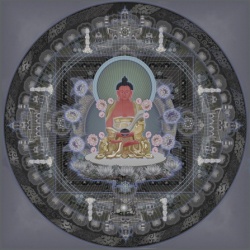Difference between revisions of "Dharmata"
Jump to navigation
Jump to search
| Line 1: | Line 1: | ||
[[File:Amitabha-mandala-tume.jpg|thumb|250px|]] | [[File:Amitabha-mandala-tume.jpg|thumb|250px|]] | ||
| − | [[Dharmata]] ([[chos nyid]]). The [[innate nature]] of [[phenomena]] and [[mind]]. | + | [[Dharmata]] ([[chos nyid]]). The [[innate nature]] of [[phenomena]] and [[mind]]. [[dharmata]] ([[zhenrú]], [[cho nyi]]): [[Phenomena]] as it really is or as seen by a completely [[enlightened being]] without any distortion or {{Wiki|obscuration}}. [[True]] or [[absolute reality]].” Often translated as “[[true suchness]]” or the “[[true nature of things]].” |
| + | |||
| + | See also; “[[bhuta-tathata]]” and “[[Distinguishing Dharma and Dharmata]].” | ||
see also; [[Tathatā]] | see also; [[Tathatā]] | ||
Revision as of 11:00, 28 March 2014
Dharmata (chos nyid). The innate nature of phenomena and mind. dharmata (zhenrú, cho nyi): Phenomena as it really is or as seen by a completely enlightened being without any distortion or obscuration. True or absolute reality.” Often translated as “true suchness” or the “true nature of things.”
See also; “bhuta-tathata” and “Distinguishing Dharma and Dharmata.”
see also; Tathatā
